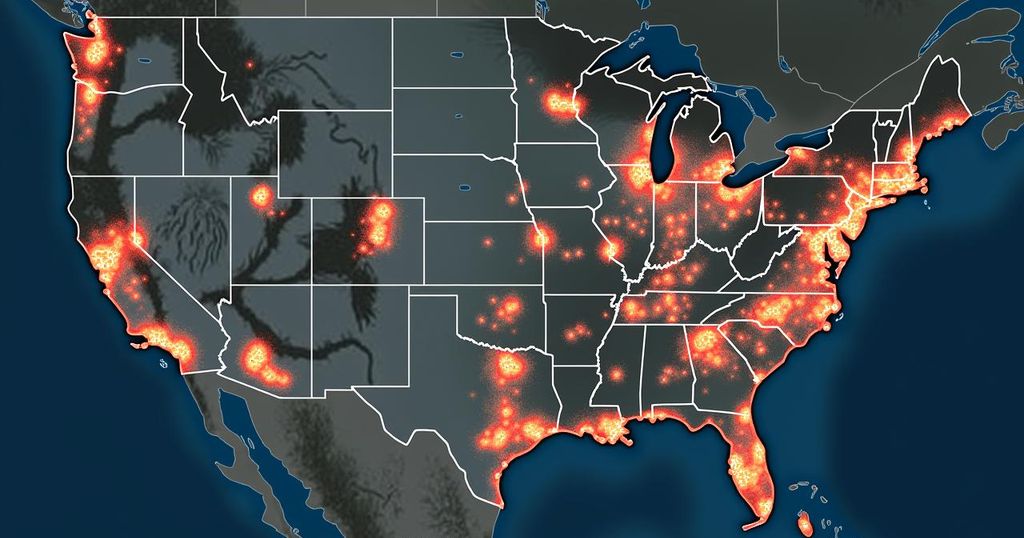U.S. Faces Risk of New Storm Systems After Hurricane Helene’s Devastation
The U.S. is at risk of facing more storms as new systems approach the Atlantic, following Hurricane Helene’s devastation. Meteorologists are tracking two potential tropical cyclones, with one having an 80% chance of development and another at 50%. Cleanup from Helene continues as communities brace for possible new storms, particularly the system that may soon become Hurricane Kirk.
The United States is bracing for additional weather challenges as fresh storms emerge over the Atlantic, raising concerns for millions of Americans still recovering from Hurricane Helene. Meteorologists are tracking two weather systems in the eastern tropical Atlantic, with the National Hurricane Center (NHC) reporting that one has an 80 percent likelihood of developing into a tropical cyclone within the week. Another system located in the western Caribbean has a 50 percent chance of evolving into a tropical depression, prompting alerts for the U.S. Gulf Coast to closely monitor its progression. The most pressing concern is a weather system currently classified as “Tropical Depression Twelve,” which will be renamed “Kirk” upon becoming a hurricane. At present, the specific trajectory or landfall of this system remains uncertain. Following Hurricane Helene, which left a trail of destruction across Florida and up the eastern seaboard, monitoring of subsequent storms is particularly critical. Helene was categorized as a powerful Category 4 hurricane, resulting in over 100 fatalities and leaving more than a million Americans without power due to severe flooding and storm surges. The trail of devastation extended beyond Florida, affecting Georgia, South Carolina, North Carolina, Tennessee, and reaching as far north as Virginia, West Virginia, Illinois, Ohio, and Kentucky. As anxious residents look to the heavens, the Miami Herald has highlighted new weather systems potentially heading towards the Gulf of Mexico from the western Caribbean Sea. The NHC reinforced its vigilant monitoring status on social media, indicating a medium chance of tropical depression formation in these regions, specifically warning interests in the northwestern Caribbean and U.S. Gulf Coast to remain alert to its developments. In addition, NHC noted on their social media platform that they are tracking two other systems in the eastern tropical Atlantic, with one exhibiting an 80 percent chance and another a lower 20 percent chance of becoming a tropical cyclone. A tropical cyclone, which can escalate into a hurricane, is characterized by sustained wind speeds exceeding 74 miles per hour. Currently, no formal warnings have been issued as the agency continues to update the public on these developments. Amidst these meteorological challenges, cleanup efforts are ongoing, and communities are in mourning as they grapple with the aftermath of Hurricane Helene’s devastating passage. The Saffir-Simpson Hurricane Scale categorizes hurricanes from Category 1 to Category 5, with Category 4 storms possessing winds ranging from 131 to 155 mph, reflecting Helene’s destructive force.
The article discusses the potential risks posed by new storm systems forming in the Atlantic, particularly in the wake of Hurricane Helene’s impact on the United States. It provides insights from meteorologists and the National Hurricane Center regarding the likelihood of these systems developing into tropical cyclones, and underscores the ongoing recovery efforts from Hurricane Helene, which caused substantial destruction across multiple states. Moreover, it highlights the importance of monitoring current weather systems to mitigate any further disasters.
In summary, the United States is currently facing the threat of additional storms as meteorological systems develop in the Atlantic, bringing uncertainty and anxiety to regions still recovering from Hurricane Helene. The National Hurricane Center is actively monitoring these systems, especially Tropical Depression Twelve, which may become Hurricane Kirk. As communities focus on recovery, it is crucial to remain vigilant of evolving weather conditions that could further challenge disaster relief efforts.
Original Source: www.newsweek.com




Post Comment